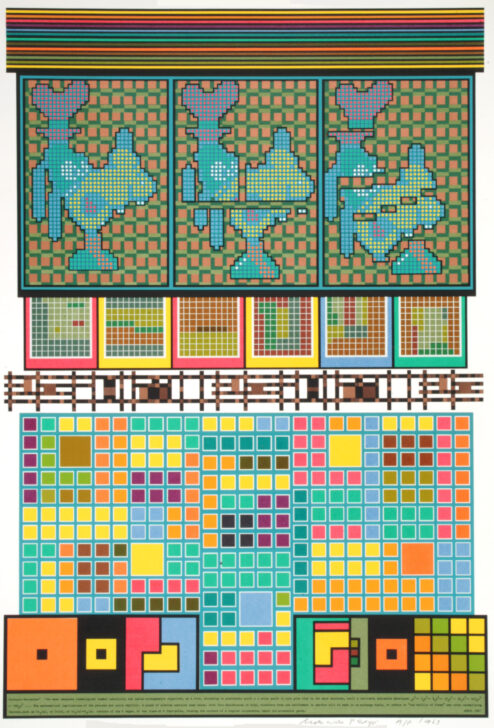Protocol-Sentences
Sir Eduardo Paolozzi ; Kelpra Studio Ltd, London

Description
Subject Matter:
As one of the founders of the Independent Group, Paolozzi was an early British Pop artist. This series of ten prints came after his travels in California, where he visited tourist sites like Disneyland, Frederick's of Hollywood, and Paramount Studios, as well as centers of technology: UC Computer Center, Standord's Linear Accelerator center, Douglas Aircraft Company and the GM Assembly Plant in Hayward. The combination of imagery from popular culture, in this case Goofy, and the technological imagery of dot matrixes and circuit boards creates a stage in which art and science can be in dialogue.
Physical Description:
Very colorful print with a series of colored bands, separated with black lines, at the top. Below the rainbow-colored bands are three fragmented images of the head of the Disney character Goofy, in teal, pink, yellow and white. The main portion of the print below has a series of differently organized and vibrantly colored grids and square patterns. At the base, there is an olive colored box, outlined in black, with black text reading: "Protocol-Sentences' the most adequate cosmological symbol centricity and radial arrangements organized, as a rule, according to quaternary point p a point would in turn give rise to yet more neutrons until a veritable avalanche developed: [mathematical equation] / [mathematical equation] .... The mathematical implications of the process are quite explicit. A pound of uranium contains some needs. With this desideratun [sic] in mind, transfers from one setttlement to another will be made on an exchange basis, or refers to "the nullity of forms" and other normalizing / factors, such as [mathematical equations], centers of the 6 edges. Wi One class of 6 four-poles, forming the corners of a regular octahedron; hence the octagedral group. / APRIL 1967". Print is signed and dated (l.r.) in pencil " Eduardo Paolozzi A/P 1967".
Usage Rights:
If you are interested in using an image for a publication, please visit https://umma.umich.edu/request-image/ for more information and to fill out the online Image Rights and Reproductions Request Form.